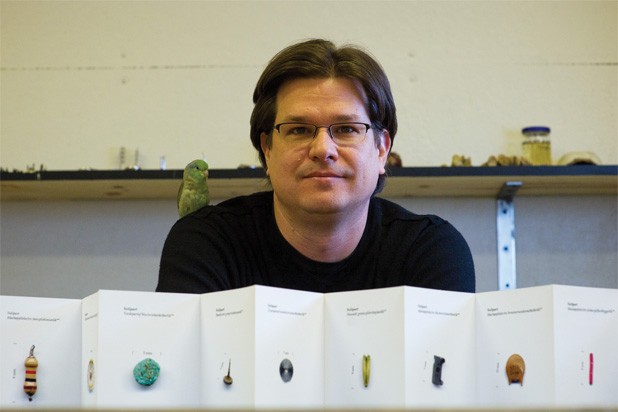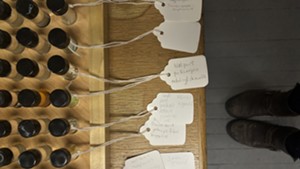
- Andy Duback
- Brian Collier
Brian Collier’s artwork is for the birds. The St. Michael’s College professor has probably heard that cliché before, but it’s hard to resist applying it to a project called “Bird Shift.” The subtitle of Collier’s current multimedia exhibit at the University of Colorado Museum of Natural History is “The Anthropogenic Ornithology of North America,” and its overarching purpose is to examine “how humans are affecting bird activity and habitat.” In a corollary project, Collier is investigating “the ornithology of big-box stores,” referring to the avian life often found within the cavernous quarters of such retailers as Home Depot.
Wait. This is art?
Sure. If you allow that an artist can research a subject as diligently as any scientist, and then use photographs, created and found objects, videos, web-based elements, installations, and printed pieces to make a case about such issues as the swelling population of certain bird species and its correlation with the intentional behaviors of certain humans. If you allow that an artist can be a dedicated environmentalist in disguise.
And he can: Collier, an assistant professor of fine arts at St. Mike’s, is interested in the “ways in which elements of the nonhuman natural world exist, or have reinserted themselves, in severely human-altered habitats,” he writes in his artist statement. His mission is “about making connections, modeling ways we can interact with the world that’s more sustainable.” If all that sounds wonky, Collier clarifies, “I’m a wannabe scientist, but I’m very clear on the distinction: This is art, not science.”
Collier, 41, is dark-haired and bespectacled with a serious mien; he seems almost wary when meeting for an interview on a recent morning. But he’s not shy about explaining his work, and his passion for the subject soon emerges. So does his wry sense of humor. Collier arrived on campus this fall to teach sculpture and digital media. He’s been setting up new labs and building a woodworking shop, he says. But you wouldn’t guess any of that from visiting Collier’s neat studio in Sloane Hall on the Fort Ethan Allen campus. It’s a large and sparsely furnished room, with a desk and a chair, a kitchen-size wood table, and a few more chairs.
The bigger table holds a very thick, square, handmade book with accordion-fold pages — it’s The Collier Classification System for Very Small Objects, which contains an entire language Collier has invented along the lines of scientific taxonomy. It offers words that mean, for example, “once living” and “found on the sole of a shoe” and “to accumulate in corners.” The book could be displayed completely unfolded if you had a very long expanse of wall, Collier notes.
On the table, too, are some of those “very small objects,” catalogued, stored in tiny glass vials and tucked inside wooden boxes like, well, specimens. Other items are waiting to be processed, he says. Collier’s definition of very small: “Any object that is visible to the naked eye but small enough to go unnoticed most of the time.” It might be an unidentifiable piece of debris lurking under your couch cushions, or a minute fragment of animal bone in the backyard.
Also on the table, curiously, is a brown paper grocery bag filled with carp — stuffed ones stitched in silvery fabric, made for a different project. “I was showing my class how to sew,” Collier explains. A couple of black megaphones — one large, one small — are used in the public tours he’s been known to lead in association with his exhibitions.
Along an adjacent wall, a long, narrow shelf displays some slightly larger found objects, meticulously organized by type and size. This collecting obsession preceded Collier’s focus on birds, but his gathering and cataloguing of very small objects is ongoing, he says.
So is his starling project, which literally announces itself when you enter Collier’s studio. Just over the threshold, a handmade wooden birdhouse labeled “Teach the Starlings: Audio-rigged Nestbox” hangs on the wall. When the motion of a passerby triggers it, a shrill “Schieffelin!” sounds. The voice is supposed to be that of a starling — a bird that, Collier says, is a great mimic. It is shrieking the surname of New Yorker Eugene Schieffelin, who introduced starlings to North America in the late 19th century.
Schieffelin was a founding member of the American Acclimatization Society, whose then-trendy mission was to bring animals and plants to new habitats — apparently before the concept of “invasive species” was understood. In particular, Schieffelin wanted to introduce this continent to all the birds mentioned in Shakespeare’s works, notes Collier. Bird-brained, indeed. Such Euro-centric thinking also brought us pigeons and house sparrows.
Collier’s “Teach the Starlings” project involves “telling the story,” he says, and “teaching all the starlings in North America to say the name of the man who introduced them here.” He admits, with a slight smirk, that the latter is “a ridiculous goal” — though guiding groups of people with megaphones to shout “Schieffelin” at starlings is part of his M.O.
But Collier is perfectly serious about the effect of human hubris on the natural environment, and his faux-scientific, tongue-in-cheek methodology is meant to raise awareness, to “reveal the stories of natural history,” as he puts it. In this story, “human activity has completely altered the term ‘North American birds,’” says Collier, who has an adopted parrotlet at home named Sprout.
As a sort of “umbrella for all of my ecological projects,” Collier invented a membership-based organization, the Society for a Re-Natural Environment, whose stated purpose is “disseminating information regarding often-overlooked, everyday experiences of the unmanaged non-human world.” Collier admits he has used the “authority” of the organization, and its official-looking brochure, to wrangle access as needed. “I inhabit the role of the earnest scientist, with tan and green outfits,” he says. “It’s amazing how people react to you in a uniform.”
All of this, remember, is an art project.
The exploration of big-box “aviaries” is a more recent extension of Collier’s “Bird Shift” project. Though he stresses, “I am not a birder,” he readily leads the way on a birding excursion — to the nearby Lowe’s in Essex. As he always does, Collier brings his camera to photograph any creatures we might see. That attracts attention immediately; no fewer than three salesclerks offer assistance as we head to the outdoor section of the store.
“The first way to find birds is by listening,” Collier says quietly. Wandering through the towering stacks of merchandise, head tilted upward, he soon spots a female cardinal — a “rare thing” in these places, he says. The confused bird is hurling herself against a skylight, not realizing that she could head downward and fly out the open side of the enclosure. After adjusting his lens, Collier snaps a few pictures. That cues a nearby clerk to inform him sternly that taking photographs inside the store is not allowed.
“How could I get permission to take photographs?” Collier asks innocently, putting the camera away.
“You’d have to get in touch with our corporate office,” says the clerk.
As he walks away, Collier confides that he’s already done that with every big-box retailer in the area. “Mostly they ignore me,” he says; “some have said they wouldn’t let me.” So he just goes in and takes pictures until someone tells him to stop.
Collier recalls discussing his project with one employee, who told him the bird population in that store was on its fifth generation. “They have this interesting human-related history,” Collier says of the birds; usually sparrows inhabit the high-ceilinged spaces, often near some food source. “Their choice to live here is an extension of that.
“It’s a strange life, kind of zoo-like,” Collier adds, noting that for his project he has designed special awnings to “cap the top shelves to protect the merchandise from bird shit.” He’d also like to see plants on the top shelves to give birds a place to rest, and envisions shoppers pushing carts beneath a dropped ceiling of clear Plexiglas “so the kids can identify the birds they see,” says Collier.
So far, he hasn’t convinced any stores to embrace the birds’ presence, but a guy can dream. After all, Collier says, “The natural-world experience is everywhere; it’s not an exotic thing. This project is about getting people to see that.”
It’s also plainly about the irreversible effects of human intervention. “Environmental problems are ongoing; they’ll never go away,” says Collier. And neither will artists who show us what we’ve done.











Comments
Comments are closed.
From 2014-2020, Seven Days allowed readers to comment on all stories posted on our website. While we've appreciated the suggestions and insights, right now Seven Days is prioritizing our core mission — producing high-quality, responsible local journalism — over moderating online debates between readers.
To criticize, correct or praise our reporting, please send us a letter to the editor or send us a tip. We’ll check it out and report the results.
Online comments may return when we have better tech tools for managing them. Thanks for reading.